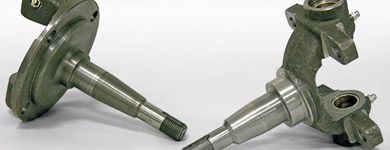
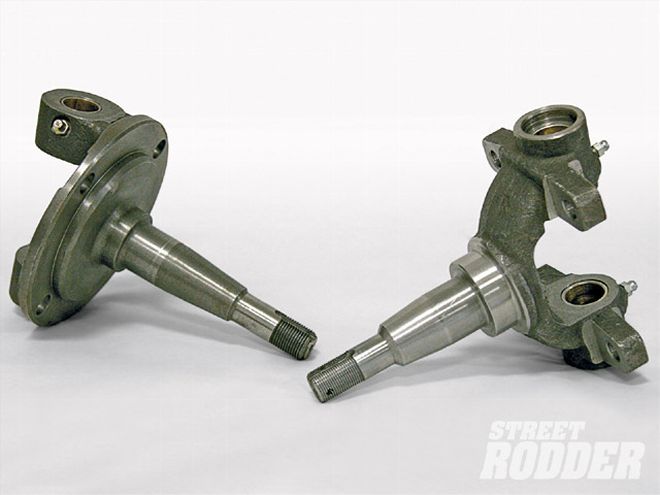 The Ford-versus-Chevy debate isn't limited to just engines. Street rodders can choose between reproduction Ford-style spindles (left) or Chevy-style spindles for tube axles. Both of these spindles come from Speedway Motors.
The Ford-versus-Chevy debate isn't limited to just engines. Street rodders can choose between reproduction Ford-style spindles (left) or Chevy-style spindles for tube axles. Both of these spindles come from Speedway Motors.
Street rodders always seem to come back to the basics. After spending several decades adapting a variety of independent front suspensions to pre-'48 vehicles, rodders are again embracing solid-axle, buggy-spring front suspensions. The revival of the Gasser look even has straight axles being shoved under many '50s- and '60s-era street machines.
All of this new interest in old suspensions can generate a lot of questions from those just entering the hobby. Heck, it can even be confusing for those who have been around for years. One common conundrum is deciding which spindles to use on your early Ford-style front axle. Today's rodder can scrounge for one of several styles of original Ford spindles or select from reproduction versions of the same. Another popular option is using reproduction 1949-54 Chevy-style spindles on a tube axle. Given such choices, the selection process can get a little puzzling.
We recently consulted the seasoned tech experts at Speedway Motors to help make sense of the straight-axle spindle choices available to modern rodders. Speedway manufactures both Ford- and Chevy-style spindles. Each style is made using a high-quality forging process and high nickel content steel, so they are exceptionally strong and durable. They are also manufactured with updated designs that make them superior to original components.
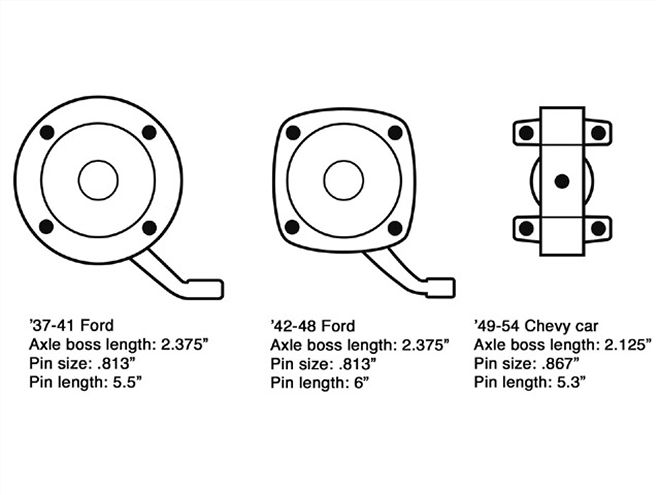 This diagram is helpful for identifying '37-41 and '42-48 Ford spindles and '49-54 Chevy spindles. On original Ford spindles, the steering arms are part of the spindle forging and require heating and bending to work with dropped axles. Original Chevy passenger car and truck spindles look very similar, but the truck spindles are taller. Chevy car spindles measure 3-13/16-inches between the upper and lower backing plate bolt holes; pickup spindles measure 4-5/16-inches. It's the Chevy car spindles that have been adapted for use on street rod axles.
This diagram is helpful for identifying '37-41 and '42-48 Ford spindles and '49-54 Chevy spindles. On original Ford spindles, the steering arms are part of the spindle forging and require heating and bending to work with dropped axles. Original Chevy passenger car and truck spindles look very similar, but the truck spindles are taller. Chevy car spindles measure 3-13/16-inches between the upper and lower backing plate bolt holes; pickup spindles measure 4-5/16-inches. It's the Chevy car spindles that have been adapted for use on street rod axles.
A Little History
In the early days of hot rodding, spindle choice was somewhat obvious-you put a Ford spindle on a Ford axle. But even then there was some mixing and matching to be done. One common swap was to use 1937-48 spindles on earlier axles. This allowed rodders to use the much better hydraulic drum brakes rather than mechanical drums. Later on, rodders learned to adapt F-100 truck brakes and larger Buick drum brakes to these spindles.
As street rodding evolved in the later-'60s and 1970s, a quest for better brakes led some rodders to adapt 1949-54 Chevy passenger car spindles to early Ford axles. The Chevy spindles had the advantage of using hubs that were separate from the brake drums. And since Corvettes used essentially the same style spindles through 1962, you could remove the brake drum assembly from the Chevy hub and slip a Corvette disc brake rotor in its place. Then it was simply a matter of fabricating a caliper bracket out of flat plate and voila! You have disc brakes on your street rod!
Chevy spindles offered additional benefits beyond disc brakes. Back in the '70s and '80s, they were much more plentiful in junkyards than early Ford pieces. And unlike Ford spindles, the Chevy pieces had separate bolt-on steering arms, making it easy to fabricate custom dropped arms for dropped axles. It also made it easier to flip the steering arms around and locate the tie rod in front of the axle, a common practice on T-buckets at the time. In a similar vein, rodders building straight-axle Gasser-style cars could mount the steering arms on the tops of the spindles, making it easier to connect a steering system on these jacked-up rides.
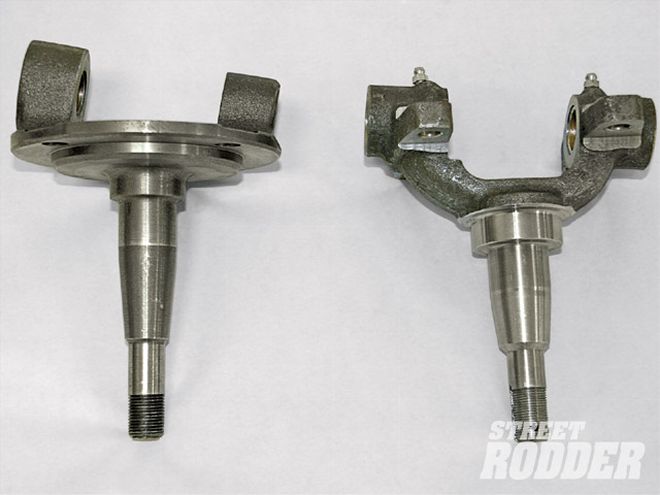 This photo illustrates the distinct difference in kingpin inclination between the Ford- and Chevy-style spindles. Also note that the Chevy-style spindle has a shorter, thicker axle stub, which arguably makes it a slightly stronger design than the Ford.
This photo illustrates the distinct difference in kingpin inclination between the Ford- and Chevy-style spindles. Also note that the Chevy-style spindle has a shorter, thicker axle stub, which arguably makes it a slightly stronger design than the Ford.
The Chevy spindle swap required a bit of work to pull off on stock Ford beam axles. You had to bore out the kingpin boss on the axle to accept the larger Chevy kingpin and machine the ends, since the Chevy kingpin was shorter. The Chevy spindles were also designed for a different kingpin inclination than Fords, so it was necessary to heat and bend the axle ends to get proper camber. To help avoid this work, many manufactures began building tube axles specifically designed to accept Chevy spindles.
As time went on, other disc brake choices became available for Chevy spindles. One option employed Volvo parts. Others used later-model GM rotors and calipers, which required some machine work on the spindles. In fact, for many years Speedway Motors offered a machining service for customers who wanted to modify their original Chevy spindles to accept newer disc brakes.
Modern Options
Today, high-quality forged reproduction spindles like those from Speedway Motors offer rodders plenty of versatility without the need to scrounge for old parts or farm out expensive machine work. So if strength and availability are no longer issues, what criteria should you use to choose between Ford- and Chevy-style spindles?
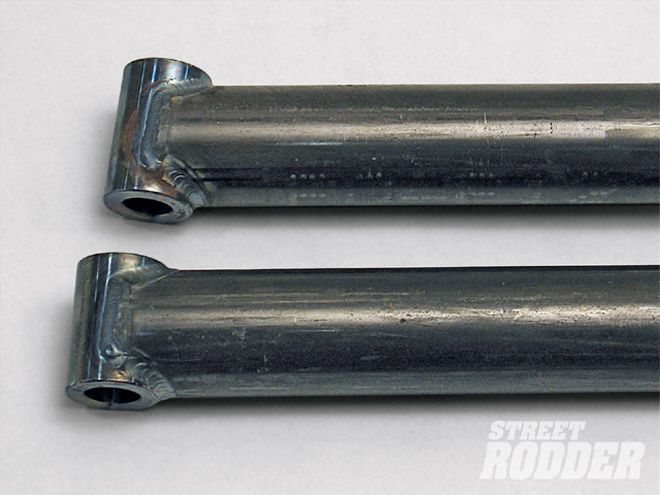 Look closely and you can see the different angles on the kingpin bosses on these tube axles made for Ford-style (top) and Chevy-style (bottom) spindles.
Look closely and you can see the different angles on the kingpin bosses on these tube axles made for Ford-style (top) and Chevy-style (bottom) spindles.
Rodders seeking an authentic nostalgic look will naturally gravitate toward Ford-style spindles. Speedway's reproduction versions are the round-back, 1937-41 style, and are designed to use bolt-on steering arms for more versatility (Speedway offers six different styles of arms). You can use them with drum brakes for a true period appearance, or select from several different styles of disc brake kits for improved modern braking. Ford-style spindles will almost always be your best choice when using an original Ford axle or aftermarket beam axle.
Chevy-style spindles are a great choice for a variety of applications using tube axles. A shorter, thicker axle stub makes it a stronger design than the Ford spindle, which is worth considering on larger, heavier street rods. Speedway Motors' version of the spindle is built to direct mount common GM and Ford disc brake rotors without machine work or adapters. It also has improved kingpin geometry to work better with modern radial tires. Speedway offers two styles of steering arms for these spindles (for both traditional and cross steering) and, as noted earlier, the arms can easily be mounted to the top or bottom of the spindle. This makes them a good choice for Gasser-style straight axle setups.
The accompanying photos and diagrams will help clarify differences in these two popular styles of spindles. Armed with this information, you should have no problem making the right choice for your next solid axle project.